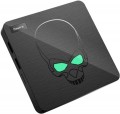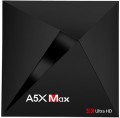Bluetooth
Bluetooth is a technology used to connect various devices wirelessly directly. In media centers and TV receivers, it can be used to broadcast sound to wireless headphones and acoustics, to work with wireless mice and keyboards, to use a smartphone / tablet as a remote control, etc.; specific functionality should be specified separately. Also note that the supported version of Bluetooth can be specified here. The newest and most advanced is
Bluetooth 5.0, but here is a more detailed description of the different versions:
- Bluetooth v4.0. The version in which the "Bluetooth Low Energy" (LE) format was first introduced — in addition to regular Bluetooth (version 2.1 functionality) and the high-speed HE standard for transferring large amounts of information (introduced in version 3.0). Bluetooth LE allows you to significantly reduce power consumption when transmitting small data packets, such as request-responses about connection activity in idle mode. For the media centers and TV receivers themselves, this is not particularly important, but for portable equipment (especially miniature ones, where battery capacity is very limited), such functionality will be useful.
- Bluetooth v 4.1. Development and improvement of Bluetooth 4.0. One of the key improvements was the optimization of collaboration with 4G LTE communication modules so that Bluetooth and LTE do not interfere with each other. In addition, this ve...rsion has the ability to simultaneously use a Bluetooth device in several roles — for example, to remotely control an external device while simultaneously streaming music to headphones.
- Bluetooth v4.2. Further, after 4.1, the development of the Bluetooth standard. It did not introduce fundamental updates, but received a number of improvements regarding reliability and noise immunity, as well as improved compatibility with the Internet of Things.
- Bluetooth v5.0. Version introduced in 2016. One of the most notable updates was the introduction of two new modes of operation for Bluetooth LE — with an increase in speed by reducing the range and with an increase in range by reducing the speed. In addition, a number of improvements have been introduced regarding simultaneous work with numerous connected devices, as well as work with the components of the Internet of Things.
Wi-Fi
Wi-Fi is a technology used for wireless connection to computer networks and for direct connection between devices. In media players, tuners and video capture devices, it can be used both to access the Internet or "local area" through a wireless router, and to communicate with a smartphone, tablet, etc. The
AirPlay, Chromecast and Miracast functions are also based on this technology. The specific set of Wi-Fi features should be clarified separately; here we note that in this paragraph the specific supported version of such a connection can also be specified. Here are the main current options:
- Wi-Fi 5(802.11ac). One of the newest (for 2020) standards. Uses the 5 GHz band (less crowded than used in earlier 2.4 GHz versions) for improved reliability and lower latency; and speeds can reach 6.77 Gbps with multiple antennas and 1.69 Gbps with a single antenna.
- Wi-Fi 4 (802.11n). The predecessor of the above Wi-Fi 5, the first standard in which the 5 GHz band was introduced — here it is used along with the traditional 2.4 GHz and is not supported by some devices with Wi-Fi 4. Data transfer rate — up to 600 Mbps.
Note that, in addition to the directly claimed Wi-Fi standard, the media centre, digital receivers and video capture devices usually provide support for earlier versions — for maximum compatibility with different devices.
HDMI
HDMI is the most common modern interface for working with HD content and multi-channel audio. Video and audio signals with this connection are transmitted over a single cable, and the bandwidth in the latest versions (
HDMI 2.0 and
HDMI 2.1) is enough to work with UltraHD resolution and even higher. Almost any modern screen (TV, monitor, etc.) with HD support has at least one HDMI input, which is why most media players and TV receivers have outputs of this type. However, there are also models without HDMI — these are mostly outdated or the most inexpensive solutions that use only analogue video interfaces. There are also models for several HDMI and in most cases one of these ports is for the incoming signal, while the HDMI ports differ in versions.
— v 1.4. The version presented back in 2009, however, does not lose popularity to this day. Supports 4K (4096x2160) video at 24 fps and Full HD at 120 fps; the latter, among other things, allows you to transfer 3D video over this interface. In addition to the original v 1.4, there are also improved versions v 1.4a and v 1.4b, where the possibilities for working with 3D have been further expanded.
-v 2.0. Version released in 2013. Among other things, it introduced the ability to work with 4K video at speeds up to 60 fps, compatibility with ultra-wide format 21: 9, as well as support for up to 32 channels and 4
...audio streams simultaneously. HDR support was not originally included in this release, but was introduced in v 2.0a and further enhanced in v 2.0b; media players from this category can support both the original version 2.0 and one of the improved ones.
— v 2.1. 2017 version, also known as HDMI Ultra High Speed. Indeed, it provides a very solid bandwidth, allowing you to work even with 10K video at a speed of 120 fps; in addition, a number of improvements have been made to HDR support. Note that the full use of HDMI v 2.1 is possible only with a special cable, but the functions of earlier versions remain available when using conventional wires. Coaxial output
In this case, the term
coaxial refers to a type of SP/DIF interface that uses an electrical cable with an RCA connector. This interface provides sound transmission, including multichannel, in digital format; at the same time, the electrical cable is more susceptible to interference than the optical one, but is not as fragile.
Optical output
A variation of the SP/DIF audio interface that uses a TOSLINK fibre optic cable. Like the coaxial connector,
the optical output uses a digital data transfer format and can work with multi-channel audio. At the same time, optical fibre requires rather delicate handling, but it is absolutely insensitive to electrical interference.
CPU
The model of the CPU installed in the media player.
This information is mainly of reference value: the processor is selected in such a way as to provide certain practical characteristics (maximum resolution, support for certain standards, embedded applications, etc.). So when choosing, you should focus primarily on these specifications. However, if you wish, knowing the processor model, you can find detailed data on it and evaluate the capabilities of the media centre to work with resource-consuming applications. This can be useful, in particular, if you choose an Android model (see above) and plan to use additional software intensively — the set of applications for this OS is very extensive, and some of them are quite demanding on system resources.
Also note that CPU data is often specified for advertising purposes — to emphasize that the device has a fairly advanced chip from a well-known brand. Among the most common brands of such processors are
Allwinner,
Amlogic,
Rockchip,
Realtek.
CPU cores
The core is the part of the processor that executes a single thread of instructions. Accordingly, the presence of multiple cores allows to work with multiple threads simultaneously, which has a positive effect on performance. Theoretically, more cores (
4 cores or even
6 cores or more) can increase the efficiency of the processor. However, in fact, CPU performance depends on so many additional factors that the number of cores is purely a reference parameter. So, a high-end dual-core processor may well be more performant than an inexpensive quad-core one.
CPU frequency
The clock speed of the CPU installed in the media centre.
On the technical side, the higher this indicator, the faster the processor works and the higher, accordingly, the overall system performance. At the same time, the CPU performance depends, in addition to the frequency itself, on a number of factors — architecture, number of cores, special design features, etc.; and the actual speed of the entire system is affected by performance of components other than the processor. In addition, manufacturers usually select processors in such a way that their computing power is guaranteed to be enough for all the features claimed for a media centre. Therefore, in this case, the CPU frequency is more of a reference parameter (and partly an advertising indicator that demonstrates the advanced specifications of the device), rather than practically significant for buyer.
Built-in memory
The volume of
its own storage installed in the media player.
In this case, storage means permanent memory available to the user — the storage that you can fill with movies, music, applications, etc. The larger the volume of such storage, the more convenient it is for the user; on the other hand, this parameter significantly affects the cost of the entire device. In addition, it should noted that external media are also quite suitable for films and other multimedia content — flash drives, portable HDDs, drives installed in a slot (see below), optical discs, etc. So specifically look for a model with a capacious storage makes sense in two main cases. The first is if you want to keep an extensive collection of content in the media player, so as not to bother once again with connecting flash drives, loading disks, etc. it is best to put it in the built-in memory, and often this is the only possible option).
As for specific volumes, the capacity up to 4 GB is considered very limited nowadays; such a storage is not enough even for a movie in HD 720p, its purpose is mainly to store a small set of applications.
8 GB and
16 GB are also relatively small, but this already allows you to work with a fairly extensive set of software and store individual movies in HD resolutions. And if you initially intend to store a large amount of content on the device, you should d
...efinitely pay attention to models with a capacity of 32 GB or more.
